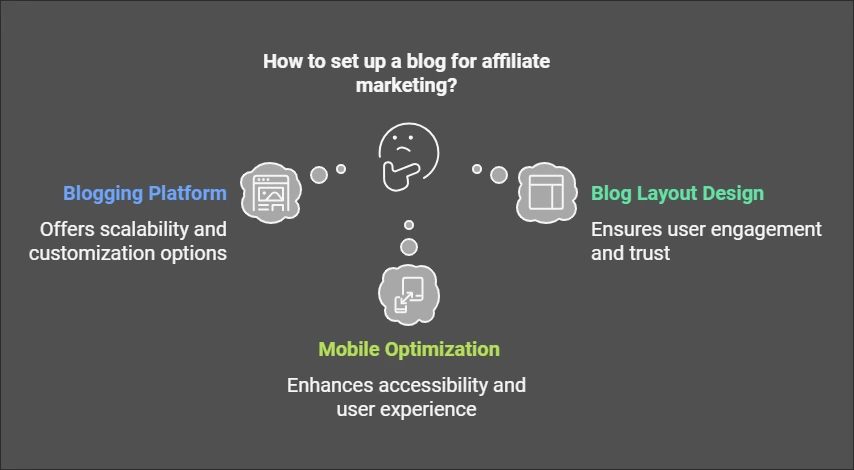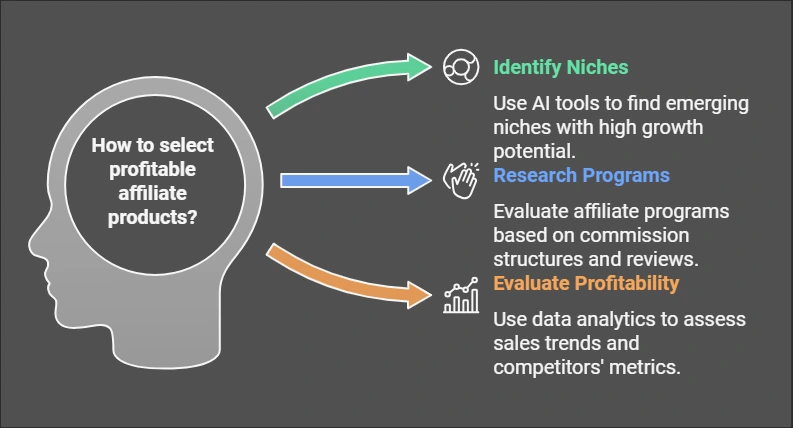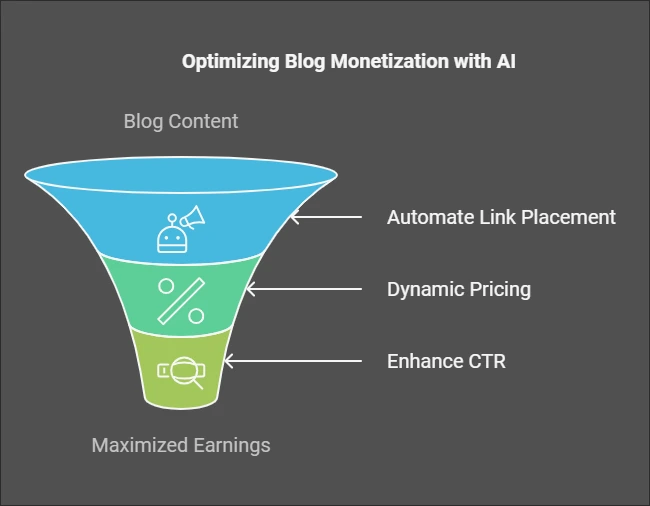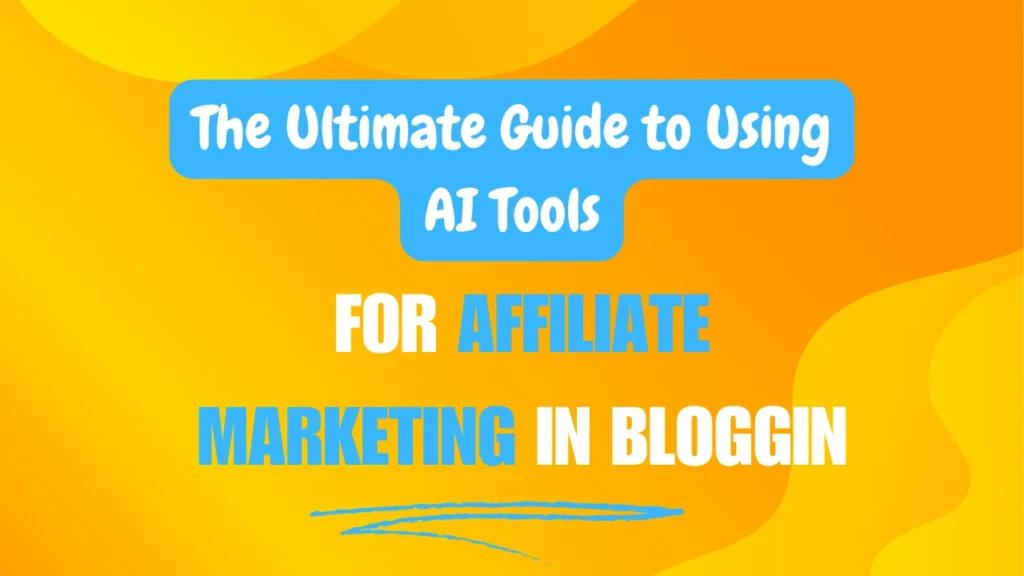Table of Contents
Love this post? Share it!
1. Introduction
Affiliate marketing and blogging are like peanut butter and jelly – they just work so well together! With the rise of digital marketing, blogging has become an influential way to share ideas, build a loyal audience, and drive conversions. Add the power of affiliate marketing into the mix, and you’ve got a recipe for a lucrative online business. Let’s explore why these two strategies complement each other so perfectly and how AI is revolutionizing the game.
1.1 Why Affiliate Marketing and Blogging Are a Perfect Match
Affiliate marketing thrives on trust and connection. People are more likely to purchase products or services recommended by someone they trust, which is exactly where blogging excels. Through engaging, authentic content, bloggers can establish authority in their niches, making their affiliate links more appealing to readers.
Blogging also allows for creative flexibility. Whether you’re writing tutorials, product reviews, or thought-provoking opinion pieces, you can weave affiliate links naturally into your content. Plus, blogs have long-term value; a well-optimized blog post can continue driving traffic and affiliate sales for years.
1.2 The Role of AI in Modern Digital Marketing
Artificial Intelligence (AI) is no longer just the stuff of sci-fi movies; it’s reshaping industries, including digital marketing. For bloggers and affiliate marketers, AI is like having a personal assistant who works 24/7. It helps automate repetitive tasks, analyze data with precision, and even create content that resonates with your audience.
AI can streamline keyword research, optimize content for SEO, personalize reader experiences, and more. The best part? AI allows marketers to focus on strategy and creativity while leaving the heavy lifting to the algorithms. Whether you’re a seasoned marketer or just starting, AI can elevate your efforts and results.
2. Understanding Affiliate Marketing
Affiliate marketing is one of the most accessible ways to monetize a blog, but understanding the ins and outs is key to success. Here’s a breakdown of what it is, why it’s effective, and the challenges you might face without leveraging AI.
2.1 What Is Affiliate Marketing?
Affiliate marketing is a performance-based marketing strategy where you earn a commission by promoting someone else’s products or services. Here’s how it works:
- You sign up for an affiliate program.
- You get unique links to share in your content.
- When a reader clicks your link and makes a purchase, you earn a commission.
It’s a win-win for everyone involved. The merchant gains exposure and sales, you earn passive income, and the customer gets a trusted recommendation.
2.2 Key Benefits of Affiliate Marketing
Affiliate marketing offers numerous advantages, especially for bloggers:
- Low Startup Costs: You don’t need to create a product or manage inventory.
- Scalability: Promote as many products or services as you’d like across different niches.
- Flexibility: Work from anywhere and set your own schedule.
- Passive Income Potential: Once your content ranks and attracts traffic, the earnings can roll in with minimal effort.
2.3 Challenges in Affiliate Marketing Without AI
Despite its appeal, affiliate marketing isn’t without challenges:
- Finding the Right Products: Manually researching profitable affiliate programs can be time-consuming.
- SEO Complexity: Ranking on search engines requires constant optimization and monitoring.
- Audience Targeting: Without insights, it’s hard to deliver personalized content that converts.
- Performance Tracking: Analyzing data to improve strategies can be overwhelming.
This is where AI comes to the rescue, turning these challenges into opportunities.
3. Exploring AI Tools for Blogging
3.1 What Are AI Tools for Bloggers?
AI tools for bloggers are software applications powered by artificial intelligence designed to simplify and improve the blogging process. They can assist with content creation, keyword research, SEO optimization, performance tracking, and much more. Essentially, they help bloggers focus on producing quality content while automating or enhancing time-intensive tasks.
3.2 Types of AI Tools for Blogging Success
Here are some essential types of AI tools that can transform your blogging journey:
- Content Generators: Tools like Jasper AI or Copy.ai can draft blog posts, headlines, and captions, saving you hours of brainstorming.
- SEO Optimizers: Platforms like Surfer SEO analyze your content and provide suggestions to boost rankings.
- Grammar and Style Checkers: Grammarly and ProWritingAid ensure your writing is polished and error-free.
- Keyword Research Tools: Tools like SEMrush or Ahrefs help identify high-ranking keywords to target.
- Analytics Software: AI-powered analytics tools track your blog’s performance and suggest areas for improvement.
By integrating these tools into your workflow, you can work smarter, not harder, and achieve better results faster.
4. Setting Up Your Blog for Affiliate Marketing

A solid foundation is essential for a successful affiliate marketing blog. From selecting the best platform to optimizing for mobile users, these initial steps set the stage for long-term growth.
4.1 Choosing the Right Blogging Platform
The right blogging platform is critical for scalability, customization, and ease of use. Popular choices include:
- WordPress: A favorite for its vast customization options and plugins. Ideal for those who want full control over their blog’s functionality.
- Wix: A beginner-friendly option with drag-and-drop features, perfect for quick setup.
- Squarespace: Known for sleek designs and integrated features, best for visually appealing blogs.
When choosing, consider your technical skills, budget, and the type of content you plan to create.
4.2 Designing a User-Friendly Blog Layout
A cluttered blog can drive readers away, no matter how great your content is. Here are some tips for designing a layout that keeps visitors engaged:
- Clear Navigation: Ensure your menus and categories are intuitive.
- Responsive Design: Use themes or templates that adapt to various screen sizes.
- Readable Fonts: Choose fonts that are easy on the eyes and maintain consistency throughout your blog.
- Call-to-Action (CTA) Buttons: Strategically place CTAs to guide readers toward your affiliate links or subscriptions.
A clean, professional design builds trust and encourages readers to stay longer.
4.3 Optimizing Your Blog for Mobile Users
With mobile devices accounting for a significant portion of web traffic, mobile optimization is non-negotiable.
- Fast Loading Speeds: Compress images and minimize plugins to improve load times.
- Mobile-Friendly Themes: Choose themes that are designed to work seamlessly on mobile.
- Clickable Elements: Ensure buttons and links are large enough to be easily tapped.
Google prioritizes mobile-friendly sites, so optimization not only improves user experience but also boosts your SEO rankings.
5. AI Tools for Content Creation
Creating compelling, optimized, and engaging content is at the heart of affiliate marketing success. AI tools can simplify this process while enhancing quality.
5.1 Using AI to Generate High-Quality Blog Content
AI writing tools like Jasper AI, Copy.ai, and Writesonic are game-changers for bloggers. These tools can:
- Generate full-length articles, headlines, or email templates.
- Save time on brainstorming and drafting.
- Offer tone and style adjustments to match your audience.
While AI can draft content, remember to add a personal touch to maintain authenticity and relatability.
5.2 Tools for Keyword Research and SEO Optimization
Keyword research is essential for driving organic traffic. AI-powered tools like SEMrush, Ahrefs, and Surfer SEO help identify high-ranking keywords and optimize your content. These tools offer:
- Keyword Suggestions: Based on search volume, difficulty, and relevance.
- Competitor Analysis: Insights into what’s working for your competitors.
- SEO Guidelines: Recommendations for improving on-page SEO.
Integrating these tools ensures your content is discoverable by search engines and resonates with your target audience.
5.3 Enhancing Readability with AI-Powered Grammar Tools
Polished, error-free writing is key to building credibility. Tools like Grammarly and ProWritingAid:
- Identify and correct grammar, spelling, and punctuation errors.
- Offer readability enhancements, such as rephrasing suggestions.
- Provide style guides to maintain consistent tone and voice.
These tools not only save time but also ensure your content is professional and engaging.
6. Finding Profitable Affiliate Products

Selecting the right products to promote is critical for affiliate marketing success. AI tools can make this process faster and more effective.
6.1 Identifying High-Converting Affiliate Niches with AI
Choosing a profitable niche is the first step. AI tools like Niche Scraper and TrendHunter analyze market trends and consumer behavior to identify:
- Emerging niches with high growth potential.
- Products that align with your blog’s theme and audience.
By leveraging data-driven insights, you can confidently enter niches with strong earning potential.
6.2 Tools for Researching Affiliate Programs
The affiliate program you choose impacts your earnings. Platforms like ShareASale, CJ Affiliate, and Amazon Associates offer:
- Detailed program listings with commission structures.
- Ratings and reviews from other affiliates.
- Insights into program performance and reliability.
AI tools can filter these programs based on your criteria, saving time and effort.
6.3 Evaluating Product Profitability Using Data Analytics
AI-driven analytics tools like Tableau and Google Analytics help assess the profitability of potential products by:
- Analyzing sales trends and conversion rates.
- Comparing competitors’ performance metrics.
- Predicting long-term profitability based on market data.
By combining AI insights with your blog’s audience data, you can confidently choose products that will generate consistent affiliate revenue.
7. Optimizing Blog Content with AI
AI offers a wealth of tools and techniques to elevate your blog content, making it more engaging, targeted, and visually appealing.
7.1 Personalizing Content for Your Target Audience
Personalization creates a deeper connection with your audience. AI tools like OneSpot and Persado help you:
- Analyze reader behavior to tailor content suggestions.
- Use dynamic content that adapts based on user preferences.
- Deliver location-based or interest-specific content.
This approach fosters trust and encourages readers to return to your blog.
7.2 AI-Powered A/B Testing for Blog Headlines
The right headline can make or break your content’s performance. AI tools like Optimizely and Unbounce simplify A/B testing by:
- Generating multiple headline variations.
- Analyzing click-through rates (CTR) in real-time.
- Identifying the most engaging headlines for your audience.
Continuous testing ensures your headlines remain impactful and relevant.
7.3 Leveraging AI for Image and Video Optimization
Visuals are key to engaging blog readers. AI tools like Canva’s Magic Resize and Adobe Sensei allow you to:
- Resize and optimize images for faster load times.
- Enhance image quality with smart editing tools.
- Create video thumbnails and captions automatically.
AI tools not only save time but also ensure that your visuals are polished and professional.
8. AI for Driving Traffic to Your Blog
Driving consistent traffic to your blog requires a strategic approach, and AI provides innovative solutions for growth.
8.1 AI Tools for Social Media Marketing
Social media is a powerful channel for promoting your blog. AI platforms like Hootsuite Insights and Buffer provide:
- Automated scheduling to post at optimal times.
- Analytics on post engagement and reach.
- Suggestions for trending hashtags and content.
Using AI for social media amplifies your blog’s visibility and attracts a broader audience.
8.2 Automating Email Campaigns with AI
Email marketing remains one of the most effective traffic-driving strategies. Tools like Mailchimp and ActiveCampaign offer AI-driven features such as:
- Personalizing subject lines and email content.
- Optimizing send times based on user activity.
- Segmenting audiences for tailored campaigns.
Automation ensures your emails are targeted, timely, and impactful.
8.3 Using AI to Analyze and Predict Traffic Trends
Understanding traffic patterns helps you make informed decisions. Tools like Google Analytics and Crazy Egg with AI capabilities:
- Track user behavior and identify popular content.
- Predict future traffic trends based on historical data.
- Highlight areas for improvement to retain visitors.
By leveraging AI analytics, you can focus your efforts on strategies that yield the best results.
9. Monetizing Your Blog with AI

AI streamlines monetization by automating tasks and optimizing strategies to maximize earnings.
9.1 Automating Affiliate Link Placement
Placing affiliate links manually can be time-consuming. AI tools like Skimlinks and ThirstyAffiliates:
- Automatically scan your content for link opportunities.
- Insert relevant affiliate links seamlessly.
- Monitor link performance to enhance conversions.
Automation ensures no earning potential is overlooked.
9.2 AI Tools for Dynamic Pricing and Offers
Dynamic pricing can boost conversions by tailoring prices to audience behavior. AI tools like Prisync and Competera help by:
- Adjusting prices based on competitor trends.
- Offering personalized discounts to specific user segments.
- Testing different pricing strategies to maximize revenue.
These tools ensure your offers stay competitive while appealing to your audience.
9.3 Enhancing Click-Through Rates with AI Insights
CTR is a critical metric for affiliate success. AI tools like Crazy Egg and ClickGUARD:
- Analyze user interactions with your content.
- Identify high-performing CTAs and optimize their placement.
- Provide heatmaps to track how readers navigate your blog.
With AI-driven insights, you can fine-tune your strategies to keep readers engaged and drive conversions.
10. Tracking and Measuring Performance
To thrive in affiliate marketing, you need to continually track and measure performance. AI tools simplify this process, providing actionable insights for improvement.
10.1 Key Metrics for Affiliate Marketing Success
Understanding the right metrics is crucial for evaluating your blog’s performance. Key indicators include:
- Click-Through Rate (CTR): Measures how often readers click on your affiliate links.
- Conversion Rate: Tracks how many clicks result in purchases.
- Average Order Value (AOV): The average amount spent per transaction through your affiliate links.
- Return on Investment (ROI): Helps determine the profitability of your marketing efforts.
- Bounce Rate: Indicates how engaged your visitors are.
Monitoring these metrics regularly helps identify what’s working and where improvements are needed.
10.2 AI Tools for Performance Analytics
AI-powered tools like Google Analytics 4, Hotjar, and Tableau provide deep insights into performance. These tools can:
- Automate data collection and reporting.
- Offer visualization dashboards to simplify complex data.
- Highlight trends and anomalies in user behavior.
With AI, you can quickly identify areas of success and optimize underperforming strategies.
10.3 Using Predictive Analytics for Long-Term Growth
Predictive analytics tools like IBM Watson and Salesforce Einstein use machine learning to forecast future trends. Benefits include:
- Anticipating User Needs: Adjust content and offers based on projected reader behavior.
- Revenue Forecasting: Estimate future earnings to plan investments.
- Trend Analysis: Stay ahead by identifying shifts in user preferences and market dynamics.
By leveraging predictive analytics, you can create a roadmap for sustainable growth.
11. Staying Ahead of the Competition
In the rapidly evolving world of affiliate marketing, staying competitive requires continuous adaptation and the smart use of AI tools.
11.1 Using AI for Competitive Analysis
AI tools like SpyFu, SEMrush, and SimilarWeb provide valuable insights into competitors’ strategies by:
- Analyzing their keyword usage and backlink profiles.
- Monitoring their ad campaigns and content performance.
- Highlighting gaps and opportunities in your niche.
This data allows you to refine your strategy and maintain a competitive edge.
11.2 Trends in AI and Affiliate Marketing
Emerging trends in AI are reshaping affiliate marketing. These include:
- Voice Search Optimization: Adapting content for AI-powered voice assistants like Alexa and Siri.
- AI Chatbots: Enhancing user engagement and support on your blog.
- Hyper-Personalization: Delivering ultra-targeted content and offers to readers.
Keeping an eye on these trends ensures you stay ahead in a competitive market.
11.3 Adapting Your Strategy with AI Insights
AI offers dynamic insights that help adapt your strategy as needed. For instance:
- Real-time analytics can highlight immediate areas for improvement.
- Behavioral analysis can guide content creation to align with audience interests.
- Predictive models can recommend new niches or products to explore.
Flexibility and responsiveness are key to staying relevant.
12. Ensuring Compliance and Ethical Use of AI
As AI becomes integral to affiliate marketing, adhering to ethical practices and regulations is more important than ever.
12.1 Understanding Affiliate Marketing Regulations
Compliance is critical for maintaining credibility and avoiding penalties. Key regulations include:
- FTC Guidelines: Ensure clear disclosure of affiliate relationships to readers.
- GDPR and CCPA: Protect user data by following privacy laws.
- Tax Reporting: Accurately report earnings to relevant tax authorities.
AI tools like Termly and Cookiebot can help automate compliance with these regulations.
12.2 Ethical AI Practices in Blogging
Ethical AI use fosters trust and maintains audience confidence. Best practices include:
- Transparency: Clearly disclose when content is AI-generated.
- Bias Reduction: Use tools that minimize biases in content recommendations.
- Accountability: Regularly audit AI-driven processes to ensure fairness and accuracy.
Prioritizing ethics enhances your reputation and strengthens reader loyalty.
12.3 Avoiding Pitfalls in AI-Driven Affiliate Marketing
While AI offers many advantages, it’s essential to avoid common pitfalls, such as:
- Over-Automation: Excessive reliance on AI can make your content feel impersonal.
- Inaccurate Predictions: Always validate AI-generated insights with real-world data.
- Regulatory Violations: Ensure AI tools comply with legal and ethical standards.
By using AI responsibly and thoughtfully, you can enjoy its benefits without compromising integrity.
13. Common Mistakes to Avoid
Success in affiliate marketing is as much about avoiding pitfalls as it is about implementing the right strategies. Here are some common mistakes and how to steer clear of them.
13.1 Overreliance on AI Tools
AI tools are powerful, but overdependence can backfire. Relying solely on AI can:
- Make Content Feel Robotic: Readers value authenticity, and over-automated content may lack a personal touch.
- Limit Creativity: AI can assist, but unique ideas often come from human insight.
- Cause Missteps: AI isn’t infallible and may generate inaccurate data or misleading insights.
Solution: Use AI as a supplement, not a replacement, for creativity and strategic thinking.
13.2 Ignoring Audience Feedback
Neglecting feedback can alienate your audience. Your readers are your most valuable resource for improvement.
- Why It Happens: AI tools might suggest strategies that conflict with what your audience prefers.
- The Risk: Failing to address feedback can decrease engagement and trust.
Solution: Regularly solicit and act on audience input to align your content with their needs.
13.3 Failing to Update Outdated Content
Outdated content can harm your credibility and SEO rankings. Common issues include:
- Irrelevant Information: Affiliate links or recommendations that no longer apply.
- Old Trends: Content that doesn’t reflect current market conditions.
Solution: Use AI tools to audit and refresh older content, ensuring it remains relevant and accurate.
14. Case Studies and Success Stories
Learning from others who have excelled with AI in affiliate marketing can provide valuable insights.
14.1 Bloggers Who Thrived with AI Tools
Example 1: A travel blogger used AI tools like Jasper to create location-specific content while utilizing SEO platforms like SEMrush to rank for niche keywords.
Result: They doubled their affiliate commissions within six months.
Example 2: A tech blogger leveraged AI analytics to identify emerging trends and write timely content, driving significant traffic spikes.
Takeaway: Strategic AI usage combined with niche expertise can yield impressive results.
14.2 Lessons Learned from Successful Affiliate Campaigns
- Diversify Income Streams: Top-performing campaigns often involve multiple affiliate programs rather than relying on a single source.
- Prioritize User Experience: Successful bloggers focus on content value, ensuring every post educates or entertains their audience.
- Measure and Adapt: Using AI tools for A/B testing and performance tracking is a common theme among winners.
Key Insight: Flexibility and data-driven decision-making are critical to sustained success.
15. Conclusion
15.1 Recap of Key Insights
Affiliate marketing and blogging are evolving, and AI offers tools to help bloggers adapt. From generating quality content to optimizing user experiences and analyzing performance, AI can empower marketers at every stage.
Key Points to Remember:
- Leverage AI to enhance—not replace—human creativity.
- Stay responsive to audience feedback and industry trends.
- Use data and predictive analytics for informed decision-making.
15.2 Embracing the Future of AI in Affiliate Marketing
The integration of AI into affiliate marketing is no longer optional—it’s the future. By embracing AI responsibly and ethically, you can build a blog that stands out, connects deeply with readers, and thrives in a competitive landscape.
16. FAQs
16.1 What Are the Best AI Tools for Beginners in Affiliate Marketing?
For beginners, tools like Jasper for content creation, Ahrefs for SEO, and Canva for graphic design are easy to use and highly effective.
16.2 How Much Does It Cost to Use AI Tools for Blogging?
Costs vary widely. Many tools offer free versions with basic features, while premium plans can range from $10 to $200+ per month. Choose tools based on your needs and budget.
16.3 Can AI Replace Human Creativity in Blogging?
No, AI is a supplement, not a replacement. It enhances efficiency and provides insights, but creativity, storytelling, and emotional connections remain human strengths.
16.4 How Do I Ensure My Blog Content Stays Authentic While Using AI?
Balance AI-generated content with personal insights and experiences. Always review and edit AI outputs to align with your brand voice.
16.5 What Are the Risks of Using AI in Affiliate Marketing?
Key risks include over-automation, potential biases in AI algorithms, and non-compliance with regulations. Mitigate these risks by auditing AI outputs and adhering to ethical practices.
By understanding and utilizing AI tools effectively, affiliate marketing in blogging becomes not only manageable but a pathway to success.

